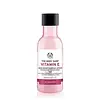What's inside
What's inside
 Key Ingredients
Key Ingredients

 Benefits
Benefits

 Concerns
Concerns

 Ingredients Side-by-side
Ingredients Side-by-side

Water
Skin ConditioningBetaine
HumectantPolyglyceryl-5 Laurate
EmulsifyingPhenoxyethanol
PreservativeButylene Glycol
HumectantGlycerin
HumectantCarbomer
Emulsion StabilisingParfum
MaskingLecithin
EmollientEthylhexylglycerin
Skin ConditioningSynthetic Fluorphlogopite
Disodium EDTA
Mica
Cosmetic ColorantSodium Hydroxide
BufferingBiosaccharide Gum-1
HumectantTheobroma Cacao Seed Extract
AntioxidantLimonene
PerfumingBenzyl Alcohol
PerfumingTin Oxide
AbrasiveAlumina
AbrasiveHexanoyl Dipeptide-3 Norleucine Acetate
Skin ConditioningCI 77891
Cosmetic ColorantCI 77491
Cosmetic ColorantWater, Betaine, Polyglyceryl-5 Laurate, Phenoxyethanol, Butylene Glycol, Glycerin, Carbomer, Parfum, Lecithin, Ethylhexylglycerin, Synthetic Fluorphlogopite, Disodium EDTA, Mica, Sodium Hydroxide, Biosaccharide Gum-1, Theobroma Cacao Seed Extract, Limonene, Benzyl Alcohol, Tin Oxide, Alumina, Hexanoyl Dipeptide-3 Norleucine Acetate, CI 77891, CI 77491
Water
Skin ConditioningGlycerin
HumectantPropanediol
SolventImperata Cylindrica Root Extract
Skin ConditioningPhenoxyethanol
PreservativeCaprylyl Glycol
EmollientAcrylates/C10-30 Alkyl Acrylate Crosspolymer
Emulsion StabilisingPPG-26-Buteth-26
Skin ConditioningArgania Spinosa Kernel Oil
EmollientTocopheryl Acetate
AntioxidantTriticum Vulgare Germ Oil
EmollientPotassium Hydroxide
BufferingSodium Acrylate/Sodium Acryloyldimethyl Taurate Copolymer
Emulsion StabilisingPEG-40 Hydrogenated Castor Oil
EmulsifyingBetaine
HumectantDisodium EDTA
Sodium Hyaluronate
HumectantXanthan Gum
EmulsifyingIsohexadecane
EmollientCarbomer
Emulsion StabilisingAloe Barbadensis Leaf Juice Powder
Skin ConditioningPolysorbate 80
EmulsifyingSodium Citrate
BufferingParfum
MaskingPEG-30 Dipolyhydroxystearate
EmulsifyingTrideceth-6
EmulsifyingSorbitan Oleate
EmulsifyingBenzyl Benzoate
AntimicrobialHydroxycitronellal
PerfumingCitric Acid
BufferingBiotin
AntiseborrhoeicWater, Glycerin, Propanediol, Imperata Cylindrica Root Extract, Phenoxyethanol, Caprylyl Glycol, Acrylates/C10-30 Alkyl Acrylate Crosspolymer, PPG-26-Buteth-26, Argania Spinosa Kernel Oil, Tocopheryl Acetate, Triticum Vulgare Germ Oil, Potassium Hydroxide, Sodium Acrylate/Sodium Acryloyldimethyl Taurate Copolymer, PEG-40 Hydrogenated Castor Oil, Betaine, Disodium EDTA, Sodium Hyaluronate, Xanthan Gum, Isohexadecane, Carbomer, Aloe Barbadensis Leaf Juice Powder, Polysorbate 80, Sodium Citrate, Parfum, PEG-30 Dipolyhydroxystearate, Trideceth-6, Sorbitan Oleate, Benzyl Benzoate, Hydroxycitronellal, Citric Acid, Biotin
Ingredients Explained
These ingredients are found in both products.
Ingredients higher up in an ingredient list are typically present in a larger amount.
Betaine is a common humectant (a substance that promotes retention of moisture). It's known to be gentle on the skin and can help balance hydration.
This ingredient is best for improving hydration and soothing irritated skin. Studies also show it helps even out skin tone.
Fun fact: Betaine is naturally created in the skin and body. The kind found within cosmetic products can be either plant-derived or synthetic.
Another name for betaine is trimethylglycine.
Learn more about BetaineCarbomer is a polymer of acrylic acid. Its main role is to create a gel consistency.
A high amount of carbomer can cause pilling or balling up of products. Don't worry, most products contain 1% or less of carbomer.
Disodium EDTA plays a role in making products more stable by aiding other preservatives.
It is a chelating agent, meaning it neutralizes metal ions that may be found in a product.
Disodium EDTA is a salt of edetic acid and is found to be safe in cosmetic ingredients.
Learn more about Disodium EDTAGlycerin is already naturally found in your skin. It helps moisturize and protect your skin.
A study from 2016 found glycerin to be more effective as a humectant than AHAs and hyaluronic acid.
As a humectant, it helps the skin stay hydrated by pulling moisture to your skin. The low molecular weight of glycerin allows it to pull moisture into the deeper layers of your skin.
Hydrated skin improves your skin barrier; Your skin barrier helps protect against irritants and bacteria.
Glycerin has also been found to have antimicrobial and antiviral properties. Due to these properties, glycerin is often used in wound and burn treatments.
In cosmetics, glycerin is usually derived from plants such as soybean or palm. However, it can also be sourced from animals, such as tallow or animal fat.
This ingredient is organic, colorless, odorless, and non-toxic.
Glycerin is the name for this ingredient in American English. British English uses Glycerol/Glycerine.
Learn more about GlycerinParfum is a catch-all term for an ingredient or more that is used to give a scent to products.
Also called "fragrance", this ingredient can be a blend of hundreds of chemicals or plant oils. This means every product with "fragrance" or "parfum" in the ingredients list is a different mixture.
For instance, Habanolide is a proprietary trade name for a specific aroma chemical. When used as a fragrance ingredient in cosmetics, most aroma chemicals fall under the broad labeling category of “FRAGRANCE” or “PARFUM” according to EU and US regulations.
The term 'parfum' or 'fragrance' is not regulated in many countries. In many cases, it is up to the brand to define this term.
For instance, many brands choose to label themselves as "fragrance-free" because they are not using synthetic fragrances. However, their products may still contain ingredients such as essential oils that are considered a fragrance by INCI standards.
One example is Calendula flower extract. Calendula is an essential oil that still imparts a scent or 'fragrance'.
Depending on the blend, the ingredients in the mixture can cause allergies and sensitivities on the skin. Some ingredients that are known EU allergens include linalool and citronellol.
Parfum can also be used to mask or cover an unpleasant scent.
The bottom line is: not all fragrances/parfum/ingredients are created equally. If you are worried about fragrances, we recommend taking a closer look at an ingredient. And of course, we always recommend speaking with a professional.
Learn more about ParfumPhenoxyethanol is a preservative that has germicide, antimicrobial, and aromatic properties. Studies show that phenoxyethanol can prevent microbial growth. By itself, it has a scent that is similar to that of a rose.
It's often used in formulations along with Caprylyl Glycol to preserve the shelf life of products.
Water. It's the most common cosmetic ingredient of all. You'll usually see it at the top of ingredient lists, meaning that it makes up the largest part of the product.
So why is it so popular? Water most often acts as a solvent - this means that it helps dissolve other ingredients into the formulation.
You'll also recognize water as that liquid we all need to stay alive. If you see this, drink a glass of water. Stay hydrated!
Learn more about Water